4-H Poultry Chain Project Guide
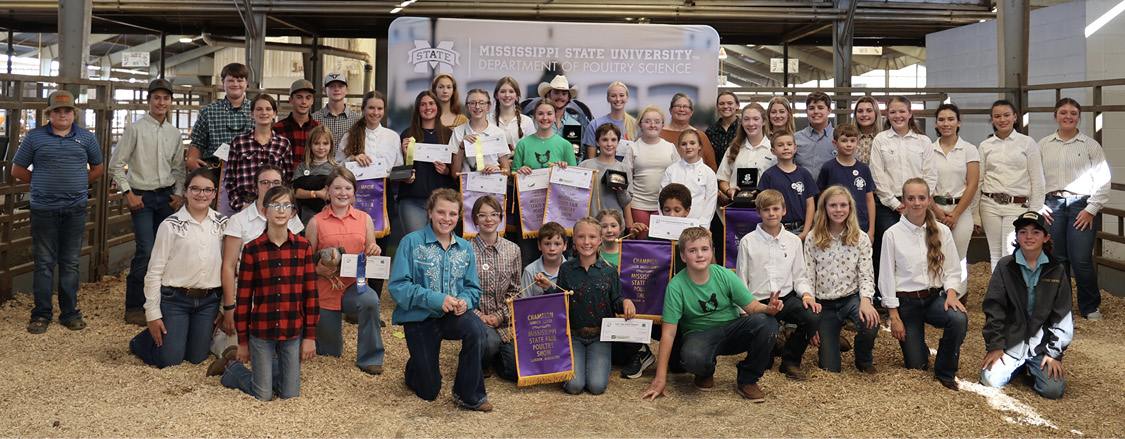
The 4-H Poultry Chain Project gives youths in the state of Mississippi the opportunity to expand their knowledge of poultry management practices and develop life skills while understanding the importance of the poultry industry to the U.S. After participating in the project, participants will have developed basic poultry management skills and awareness of diseases, as well as valuable life skills including time management, planning, communication, and responsibility.
Why Should I Choose this Project?
Poultry is Mississippi’s top agricultural commodity. An agricultural commodity is a product from a source of agriculture. The 4-H Poultry Chain Project provides youth across the state with opportunities to understand more about agriculture through a hands-on learning program, showcase their final product, and compete against other participants across the state. Participants will learn basic management practices such as brooding temperatures, how to correctly feed and provide water to birds, and the importance of biosecurity. Also, participants gain an understanding of the different breeds
of chickens, how to care for and handle eggs, how to process their own birds, the importance of recordkeeping, and more. As the leading agricultural commodity in the state, youth can learn the art of raising birds firsthand and expand their knowledge of the ever-growing industry.
What Is the 4-H Poultry Chain Project?
The project allows participants to raise birds to sexual maturity while maintaining a record book of their progress. At the end of the project, junior and senior participants will choose their top 3 birds to compete in the poultry show at the Mississippi State Fair. Once they are at the state show, participants are judged on their record books and pen of birds. There is also an optional showmanship category.
Who Can Compete?
All 4-H’ers are eligible to participate in the Poultry Chain Project. Cloverbuds are allowed to participate and compete at
the county level, while junior and senior 4-H participants are eligible to compete at both the county and state levels.
What Are the Categories?
First things first, participants must choose their category of bird. There are two categories: the Meat Category and the Layer Category. Participants can choose from either of the two categories, but they can register and show in only one category. Based on the category, participants must then choose their breed preference. It is also acceptable to choose a breed first, which will determine the category.
It is important that the selected breed is on the list of qualifying breeds. If the breed is not on the list, the participant will be disqualified from the event.
Qualifying breeds under the appropriate categories are as follows:
- Meat Category
- Any American breed: Buckeye, Chantecler, Delaware, Dominique, Holland, Java, Jersey Giant, Lamona, New Hampshire, Plymouth Rock, Rhode Island, and Wyandotte
- Layer Category
- Any Mediterranean breed: Ancona, Andalusian, Buttercup, Catalana, Leghorn, Minorca, Sicilian, and White-faced Black Spanish,
For more information on how to choose the breed that best fits your goals for the project, see Publication 3036 Choosing the Right Breed for Your Backyard Flock.
Ordering Chicks
Once you have selected your category and breed, you will need to order your chicks. Chicks must be ordered from a commercial hatchery certified by the National Poultry Improvement Plan (NPIP) or a commercial operation that is supplied by a NPIP hatchery. Be certain to call the hatchery well in advance to reserve your chicks. Order only female chicks (referred to as pullets on some websites), and be sure to order only one breed for the project. Do not order from a NPIP-certified backyard flock.
Each participant will bring a total of three birds to the state show. A fourth bird can be selected and brought separately if participating in showmanship. All birds shown in both judging and showmanship must be the same breed. To ensure you have a nice selection of birds to choose from, it is recommended to order 20 chicks; however, fewer chicks can be purchased if preferred. Just remember that you will have a smaller flock to select from for competition. Ordering in bulk for the entire county is at the discretion of the local county Extension agent.
Here are a few hatcheries or commercial operations to consider:
- Tractor supply (that is supplied by an NPIP hatchery)
- Local co-op (that is supplied by an NPIP hatchery)
- Murray McMurray
- Hoover’s Hatchery
- Ideal Poultry
- Mt. Healthy Hatcheries
- Ridgeway
Keep in mind that, while chickens do not require as much space to grow as other livestock, they still require the same amount of attention. Once a participant receives chicks and begins the project, no swaps are allowed. You may not give your birds to another individual to participate in the project.
Vaccinations
While vaccinations are not required, they are highly encouraged. This is subject to change based on regulations set by the Mississippi Board of Animal Health (MBAH).
Entry to the State Show and Testing
Typically, poultry testing is in conjunction with the livestock validation dates and locations. MBAH will announce dates, testing locations, and other information once available via email. MBAH requires three birds per participant for testing. If a family has three project participants, that family will bring three birds from each of the three participants’ flocks, so a total of nine birds would be brought with that family to the testing site.
A county show is not required to advance to the state show. If birds are in good health and vigor and have the appropriate testing, they are eligible for the state show; however, please note that participants cannot show their birds if they are not tested. The testing results list from MBAH is your entry into the state fair. Absolutely no exceptions to this rule.
How Will I Be Judged?
All participants will be judged on two sections: live birds and a record book. Half of the overall score from each section will determine the final score. The judges’ scoring criteria are listed at the end of this document.
What Is Showmanship?
Showmanship allows participants to showcase their presentation skills while demonstrating their knowledge of poultry and their excellence in the ability to examine, carry, and position their birds. Showmanship is an optional category. You may compete in the project without competing in showmanship. This is simply another opportunity for participants to demonstrate how hard they have worked on their project.
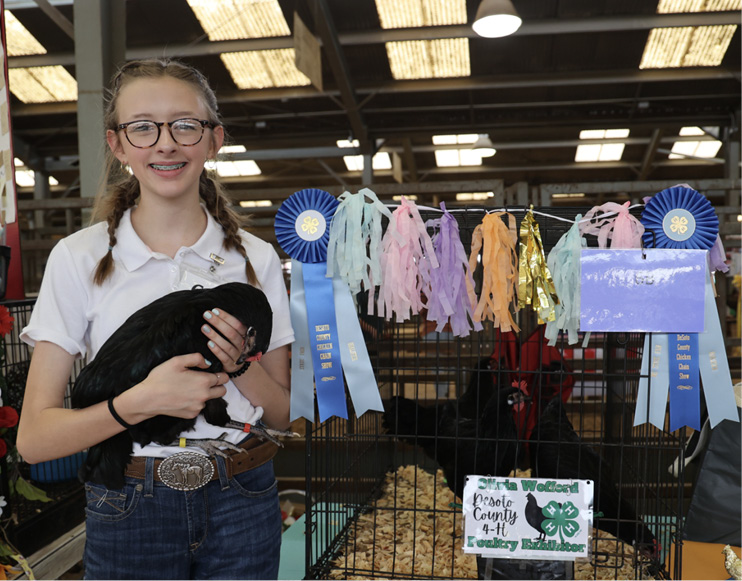
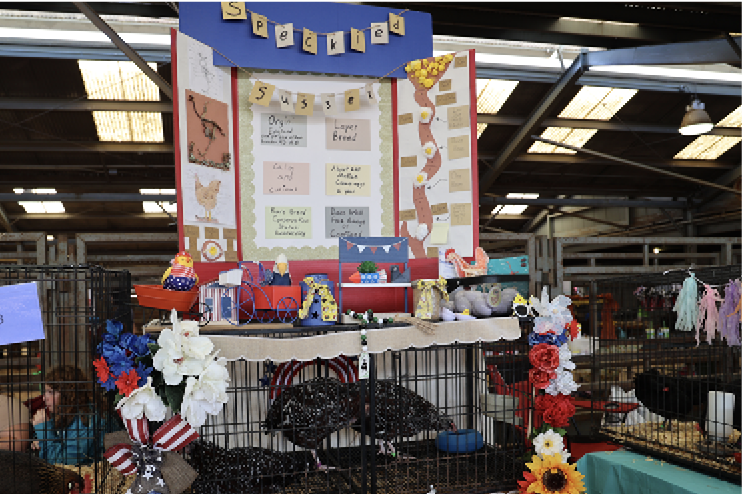
Remember, a fourth bird separate from the judging portion can be selected and brought separately for the showmanship category; however, this bird must be selected out of those birds bought for the current year’s project. Please be sure to bring an additional cage for the fourth bird to be kept separate from the three birds selected for judging.
Watch this video on the 4-H Poultry Chain Showmanship contest for more information.
Run of the Show
The run of the show is subject to change.
- 8:00 a.m.–9:00 a.m.
- Registration/check-in and record book submission
- 9:00 a.m.
- Judging and showmanship categories with awards to follow
Times are dependent on judging and showmanship times, which can vary.
Awards
Participants must be present at the state show to be eligible to win. No one other than the participant can show for the participant. All participants will receive a ribbon and certificate.
Judging
A total of 28 placings across the four categories (Junior Meat, Junior Layer, Senior Meat, and Senior Layer) will be awarded. All placings will receive a banner with the premium monetary award amounts below.
- Grand Champion $1,000
- Reserve Champion $500
- 1st Place $300
- 2nd Place $250
- 3rd Place $200
- 4th Place $150
- 5th Place $100
Grand and Reserve Champions will also receive a buckle.
Showmanship Placing
A total of four placings across the two age divisions (Junior and Senior) will be awarded. Based on the placings in each of the age divisions, participants in the optional showmanship competition will receive a banner, buckle, and the premium amounts below.
- Grand Champion $300
- Reserve Champion $150
Cutest Coop Award
This project is not only a great tool to gain a better understanding of poultry and agriculture, but also to have fun and make something on your own. An optional cutest coop category allows contestants to use their creativity and uniquely showcase their cages. This is an optional category and will not impact the point totals in any other category.
A total of two cutest coop awards will be given for each of the two age divisions (Junior and Senior). Award amounts will be dependent upon sponsorship.
Important Dates to Consider
- November: Information regarding the upcoming year’s project will be sent out and distributed by your local county Extension office.
- December/January: Interested 4-H’ers in the county should contact their local county Extension agent, decide which category they prefer, and order chicks to be delivered in May.
- April 1: Registration begins. All participants of the project should be registered in the Oracle System (Cloverbuds, Juniors, and Seniors). Contact your local county Extension agent to register for the project.
- June 15: Registration ends. Be certain you are registered in the correct category and breed.
- May 12–18: Prepare brooder and coop for chick delivery.
- May 19–25: Chick delivery week. Begin collecting data and pictures for the record book. (Remember, this is 50 percent of the overall score.)
- July: Begin preparing birds for showmanship if you haven’t done so already.
- August/September: Contact your local county Extension agent for practice showmanship sessions or local county shows where you can practice for the state show.
- October 1: Contact your local county Extension agent to confirm your participation in showmanship.
- October (always the 2nd Friday of the Mississippi State Fair): State show (Barn 13).
- November: Assess goals from the previous year as well as any issues you may have encountered, and develop a plan of action to aid in the development and growth of next year’s project.
Disqualifications
Once at the show, if your birds are not entered in the correct category, those birds will be automatically disqualified. It’s extremely important that all birds are delivered in the same week. Record books must contain the delivery/shipping information, including the date. If this information isn’t present in the record book, the contestant will automatically be disqualified from the show. If this information isn’t present in the record book, the participant will automatically be disqualified from the show.
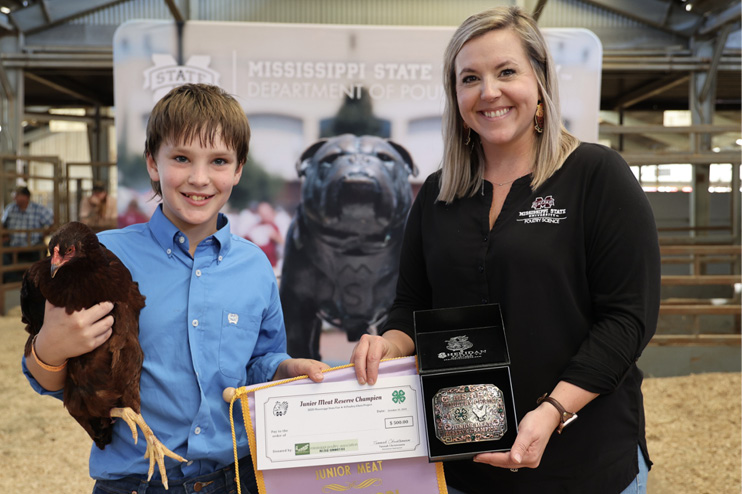
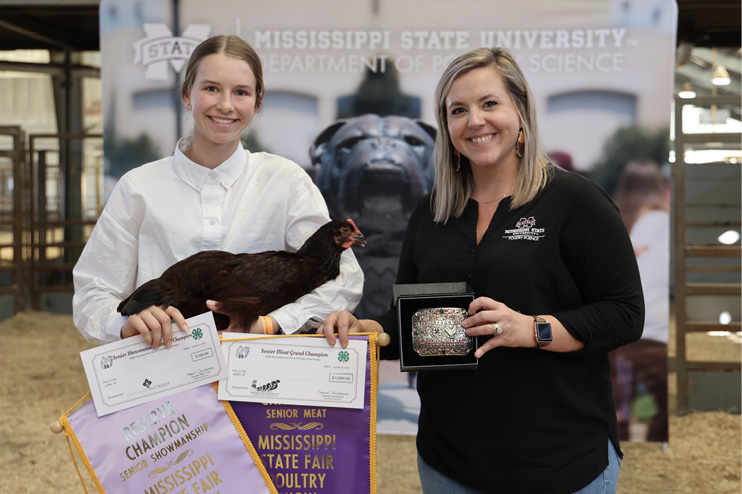
If a participant brings a breed of bird to the state show that is not on the list of eligible breeds, they will be disqualified from the contest.
Birds are also disqualified if there is no record of the birds being tested by MBAH.
Judging Criteria
50 percent of the score will be based on the group of birds, and the other 50 percent will be based on the record book.
Overall Bird Appearance (100 points total)
- Uniformity (40 points)
- Are the birds all approximately the same body size and height? Combs and wattles should be the same size.
- Cleanliness (20 points)
- Are feathers all present and clean as well as free of dirt?
- Are feet clean with no fecal material?
- Size (15 points)
- Birds are large, stand level with feet and stance wide apart.
- Adequate number of birds (15 points)
- Each participant should have three birds. Deduct 5 points for each missing bird or additional birds.
- Health and/or visible deformities (10 points)
- Are birds vibrant and alert?
- Do they have any noticeable deformities such as blind eyes, crossed beak, or feet or leg issues?
Recordkeeping Book (100 points total)
- Content (50 points)
- Does the book consist of:
- Goals agreement form (5 points)
- Letter of commitment (5 points)
- Biosecurity and welfare training certificate (25 points)
- Do they have vaccination schedules, feeding schedules, explanations of why procedures occurred, etc.?
- Neatness (20 points)
- Is the book well organized, easy to follow and understand?
- Are the pages legible and easy to read?
- Creativity (20 points)
- Is the book unique?
- Does it have pictures, illustrations, color, etc.?
- Time and effort (10 points)
- Was an ample amount of time and effort put into the project?
- Is the book appropriate to the age of the participant?
Showmanship (100 points total)
- Intro (20 points)
- Does the participant portray confidence and speak clearly?
- Did the participant clearly introduce themselves to the judge with their name, age, breed, and age of bird?
- Bird inspection (50 points)
- How well does the participant present their bird, know the parts of their bird, and possess the knowledge of their bird’s breed?
- Presentation (10 points)
- Is the participant dressed properly and confident/comfortable?
- Is the bird fitted for show? The bird should be fully feathered, clean, and free from dirt, stains, and foreign material.
- Cage Pose (20 points)
- Can the participant properly pose their bird?
- Does the participant handle their bird safely and confidently?
Cutest Coop (100 points total)
- Originality and creativity (50 points)
- To what extent do several of the graphics or objects used on the cage reflect an exceptional degree of creativity in theme and/or display?
- Is the theme executed well?
- Several graphics or objects are used.
- Is the level of detail appropriate?
- Quality of construction, neatness, and design (30 points)
- To what extent does the cage show considerable attention to construction?
- The items are neatly placed.
- All items are carefully and securely attached.
- The cage is attractive, neat, well-constructed, and not messy.
- Birds are able to move around.
- Time and effort (20 points)
- How much time and effort did it take to construct the cage design?
- Design was thoughtfully planned.
- Was an ample amount of time and effort put into the project?
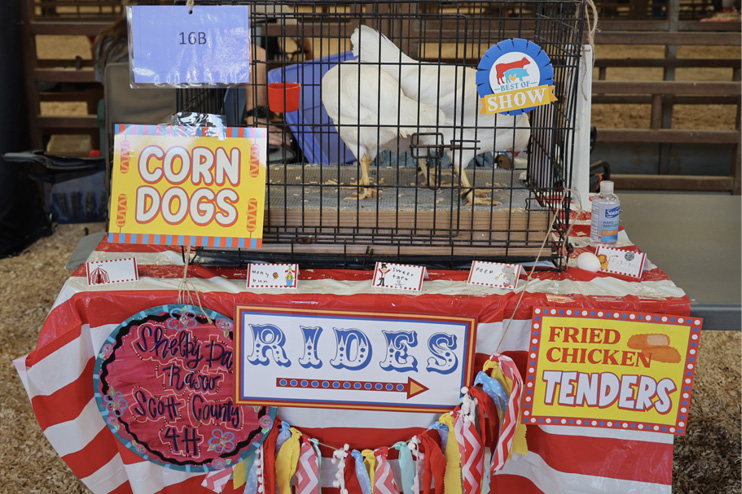
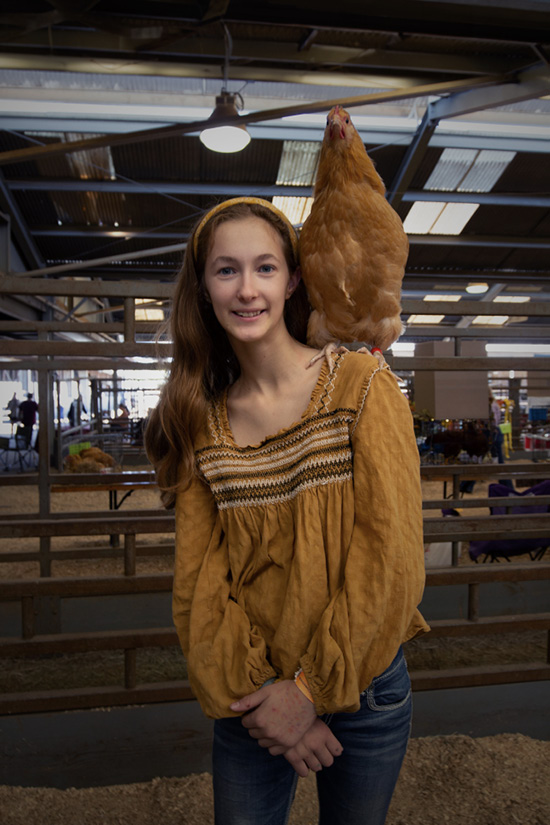
The information given here is for educational purposes only. References to commercial products, trade names, or suppliers are made with the understanding that no endorsement is implied and that no discrimination against other products or suppliers is intended.
Publication 3982 (POD-03-24)
By Tannah Christensen, Extension Instructor, Poultry Science, Jessica Wells, PhD, Assistant Teaching Professor, Poultry Science, Jonathan Moon, Extension Instructor, Poultry Science, and Peyton Taylor, Graduate Student, Agricultural Science.
The Mississippi State University Extension Service is working to ensure all web content is accessible to all users. If you need assistance accessing any of our content, please email the webteam or call 662-325-2262.






